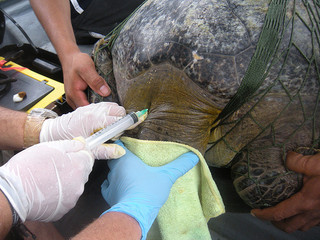As a long-time lover of nature, volunteering, and travel, I always assumed there would be certain experiences I would have in my life: I would someday get to feed a baby sloth; clean the cage of an injured monkey; and perhaps even a nighttime beach patrol to protect nesting sea turtles. But assisting in a blood test on a sea turtle? That just never crossed my mind!
Now, after some research and having had the opportunity to participate, I do know what a unique experience this is for a volunteer, a lay person like a non-marine biologist type person.
 Luckily there are many volunteer program offered in Latin America and the Caribbean in which volunteers assist the staff in the protection of sea turtles, most of them involving night patrols to keep poachers away from stealing the eggs of nesting turtles and day patrols to keep the nesting areas clear of debris. Silence and darkness must be maintained to not disturb the turtles.
Luckily there are many volunteer program offered in Latin America and the Caribbean in which volunteers assist the staff in the protection of sea turtles, most of them involving night patrols to keep poachers away from stealing the eggs of nesting turtles and day patrols to keep the nesting areas clear of debris. Silence and darkness must be maintained to not disturb the turtles.
This unique opportunity offered by Tropical Adventures in Costa Rica is different. It is one of only three programs in the world where volunteers go onboard a research boat to assist local staff in:
- Seeking information to further understand sea turtle populations, life stages, and social dynamics through the in-water study which aims to also study juveniles, adult males, sex ratios in adult populations.
- Location of critical nesting and feeding areas, develop activities to reduce the threats from main land and water habitats.
- Create and propose to local communities alternative livelihoods to reduce their impacts over sea turtles and critical habitats.
 That is a huge job for a nonprofit organization who hire staff from the local community as much as possible, but still need to rely heavily on volunteers. For a 6 to 7 hour shift out on the boat, 10 people are required to fill all the needed positions from setting out the specially made capture nets, assisting the turtle on board the vessel, filling in record sheets (time of capture, date, tag number), and ensuring sample vials are labelled, They also measure the turtle and assist staff by wiping iodine on the blood test needle or tagging site.
That is a huge job for a nonprofit organization who hire staff from the local community as much as possible, but still need to rely heavily on volunteers. For a 6 to 7 hour shift out on the boat, 10 people are required to fill all the needed positions from setting out the specially made capture nets, assisting the turtle on board the vessel, filling in record sheets (time of capture, date, tag number), and ensuring sample vials are labelled, They also measure the turtle and assist staff by wiping iodine on the blood test needle or tagging site.
And that is when I had my “pinch me, am I really here?” moment. The boat was rocking gently in the Gulfo Dulce’s warm waters. I had just watched 2 dolphins swim by. I had my eye out for passing whales and the sun was shining with just a few clouds passing over.
Did I have enough sun screen on? Should I be wearing my sunglasses? Was I keeping hydrated enough? And then – BAM! There it was..the needle, the swab, the antiseptic, blood….turtle blood. Despite years of working in a hospital, I have to admit I was not really prepared.
Assisting with a blood test for a turtle had never been on my bucket list. I’d just never considered it. Was it really dramatic? Not really. The turtle was calm and the procedure only took a minute. But it was the idea, just the idea of what I had just done! Suddenly I was overcome by that feeling that comes when one is doing something amazing and unbelievable, when you are at a loss for words and realize how lucky you are.
How lucky I felt to play a part – even a small part – in the life of an endangered sea creature. To be in one of the most beautiful areas on earth and to be working alongside others whom I felt sure, in their own way, were each feeling the same way. Wow, pinch me, is this really happening?!
Some interesting statistics about the Osa Peninsula:
- 2-3% of Earth’s flora found nowhere else
- 323 endemic species of plants and vertebrates
- Largest population of Scarlet Macaws in Central America
- 10,000+ insects
- 4,000+ vascular plants
- 700+ tree species
- 463 birds
- 140 mammals including 25 species of dolphins and whales
- 4 sea turtle species
A limited number of volunteers can be accommodated at the project at one time, so potential volunteers must book ahead, sometimes even months in advance.
Tropical Adventures, a non-profit foundation based in Costa Rica organizes everything for the new volunteer, including airport pick up and arranging travel to the area. A seven-hour trip by local bus, or a 40-minute flight to a nearby landing strip are the two options.
It is usually necessary to spend your first and last night at a hotel or hostel near the airport because of the remote location of the project. Your on-site shared accommodations and meals are included. The information like packing list was invaluable. Basically I just had to follow their advice, show up and be prepared to work hard and be amazed.
I’d highly recommend it to anyone looking for a unique experience in an area that National Geographic magazine called one of the world most biologically diverse areas in the world.

